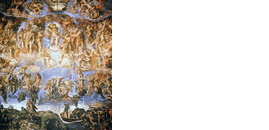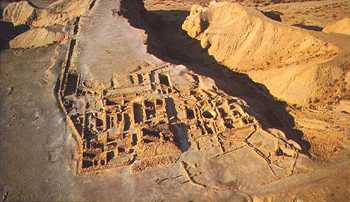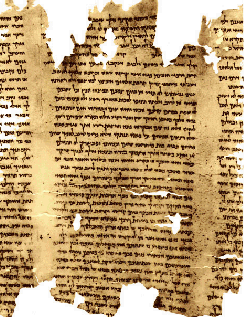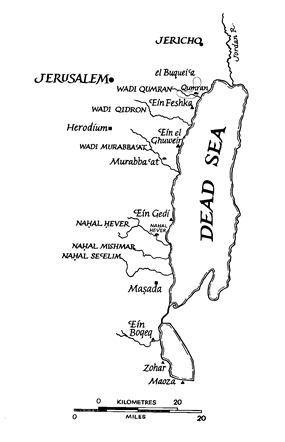
|
|
|
|
|
Class
Prep
|
|
|
|
- Utopia
before the End Times: The Dead Sea Sect
-

- About a century before the birth of Jesus, a group of Jews disaffected
with moral and cultic leadership in Jerusalem began to coalesce
around a radical interpretation of Torah and apocalyptic interpretations
of their situation. This group might have disappeared from the
pages of history but for the cache of over 800 manuscripts they
hid in caves along the northwest corner of the Dead Sea and the
ruins of a community compound left nearby. The Dead Sea Scrolls
were discovered and excavated or purchased between 1947 and 1955,
and have now almost all been published.
-
 The
long-sought publication of these manuscripts has raised more questions
than it has answered. What social fissures and political or economic
pressures combined to create this apocalyptic, utopian group?
What was the relationship between their religious beliefs, their
"communist" economy, their hierarchical political organization,
their practice or ritual meals and purifications, their self-isolation
in the desert, their pacifism? The
long-sought publication of these manuscripts has raised more questions
than it has answered. What social fissures and political or economic
pressures combined to create this apocalyptic, utopian group?
What was the relationship between their religious beliefs, their
"communist" economy, their hierarchical political organization,
their practice or ritual meals and purifications, their self-isolation
in the desert, their pacifism?
-
- You will be reading some of the chief intact sectarian documents
produced by the group. As you read the Community Rule (a kind
of constitution for the group), outline the political organization
and laws of the group, as well as the religious beliefs that seem
to motivate them. As you read the War Scroll, compare it to the
military scene we discussed in Daniel 10-12. As you read the New
Jerusalem text, discern some of the utopian impulses of the group.
What real political, economic and military realities might these
rules and future hopes reflect or oppose? Use Collins to get a
better handle on the social realities that gave rise to this group.
-
 The
final reading for today's class introduces the sociological theory
of "relative deprivation," an analytical tool that helps
to explain why social groups like apocalyptic sects form and cohere.
Does the theory appear to fit the Dead Sea Scroll sect? What analytical
obstacles are posed when the object of analysis lies so far in
the past? The
final reading for today's class introduces the sociological theory
of "relative deprivation," an analytical tool that helps
to explain why social groups like apocalyptic sects form and cohere.
Does the theory appear to fit the Dead Sea Scroll sect? What analytical
obstacles are posed when the object of analysis lies so far in
the past?
-
-
- Assigned Readings
- Primary: The Community Rule (1QS) I 1-VIII 19, The War
Scroll (1QM) 1; 15–19; The New Jerusalem (5Q15; Reddish 224-6,
229-40, with García Martínez for 1QS; ERes)
- Secondary: Collins 145-76; Aberle, "A Note on Relative
Deprivation Theory as Applied to Millenarian and Other Cult Movements"
(ERes)
- Optional: Davies, "The Social World of Apocalyptic
Writings" (ERes)
-
-
- Further Reading
-
- Collins, John J. Apocalypticism in the Dead Sea
Scrolls, The Literature of the Dead Sea Scrolls. New
York: Routledge, 1997.
-
 --------. The
Scepter and the Star: The Messiahs of the Dead Sea Scrolls and
Other Ancient Literature, Anchor Bible Reference Library. New
York: Doubleday, 1995. --------. The
Scepter and the Star: The Messiahs of the Dead Sea Scrolls and
Other Ancient Literature, Anchor Bible Reference Library. New
York: Doubleday, 1995.
-
- Duhaime, Jean. "Relative Deprivation in New
Religious Movements and the Qumran Community." Revue
de Qumran 62 (1993) 265-76.
-
 García
Martínez, Florentino. "Apocalypticism in
the Dead Sea Scrolls." In The Encyclopedia
of Apocalypticism, vol. 1, The Origins of Apocalypticism
in Judaism and Christianity (ed. John J. Collins; New York:
Continuum, 1998) 162-92. García
Martínez, Florentino. "Apocalypticism in
the Dead Sea Scrolls." In The Encyclopedia
of Apocalypticism, vol. 1, The Origins of Apocalypticism
in Judaism and Christianity (ed. John J. Collins; New York:
Continuum, 1998) 162-92.
-
- --------. Qumran and Apocalyptic: Studies on the
Aramaic Texts from Qumran, STDJ 9. Leiden: E. J.
Brill, 1992.
-
 Schiffman,
Lawrence A. The Eschatological Community of the
Dead Sea Scrolls: A Study of the Rule of the Congregation,
SBL Monograph Series 38. Atlanta: Scholars Press, 1989. Schiffman,
Lawrence A. The Eschatological Community of the
Dead Sea Scrolls: A Study of the Rule of the Congregation,
SBL Monograph Series 38. Atlanta: Scholars Press, 1989.
-
- See also the section of the Course Bibliography on Jewish
& Christian Apocalypticism, 300 B.C.E.-100 C.E.
-
-
- Links
-
-
-
- Sources
- Photograph: Duby Tal, Palphot Ltd., 25128 SC (from a postcard).
|
|
|
|
|
